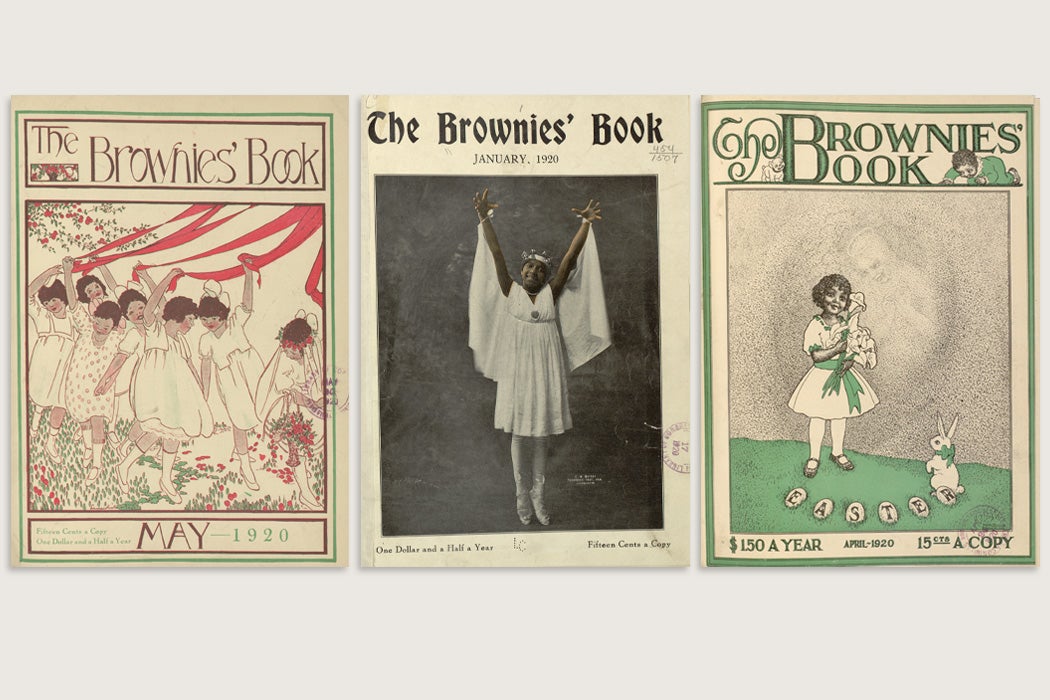“Our little girl is dark brown, and we want her to be proud of her color and to know that it isn’t the kind of skin people have that makes them great,” a parent wrote to the editors of The Brownies’ Book.
In the 1920s, magazines aimed at children like their daughter just didn’t exist. So W. E. B. Du Bois, a writer and then-editor of the NAACP magazine, The Crisis, made one a reality. When he announced the launch of The Brownies’ Book in 1919, he positioned it as “a thing of Joy and Beauty, dealing in Happiness, Laughter, Emulation, and designed for Kiddies from Six to Sixteen.” And though it was focused on Black children, it certainly wasn’t only for them. As Du Bois explained, “It will seek to teach Universal Love and Brotherhood for all little folk—black and brown and yellow and white.”
The Brownies’ Book had a short run—it was published from 1920 through 1922—but as one of the earliest periodicals for young African Americans, it was a landmark publication. As Black Studies scholar LaVerne Gyant points out, despite its brief life, it “will be remembered as a hallowed publication that sought to preserve young people’s memories and spark their curiosities through textual lineage.”
That memory is being kept alive in a new form thanks to an anthology compiled by Karida L. Brown, a professor of sociology at Emory University, and artist Charly Palmer. The New Brownies’ Book: A Love Letter to Black Families combines vintage pieces from the magazine and work by contemporary artists and writers.
The New Brownies’ Book intentionally builds on the spirit of Du Bois’s original project. In 1920, for just “15 cents a month or $1.50 for a year’s subscription,” parents could give their children something that they never had—representation. Researchers Courtney Vaughn-Roberson and Brenda Hill explain that The Brownies’ Book “offered Black children a visibility, literature, political philosophy, and direction nowhere apparent in other juvenile periodicals.”
This was particularly important, they stress, because “negative or nonexistent portrayals of Blacks in children’s literature were the norm during the nineteenth and well into the twentieth centuries.” Children’s books were filled with stereotypes. This was a time, wrote librarian Elinor DesVerney Sinnette, that Black children were “growing and developing without reading materials and concrete evidence dealing with their existence. […] Nothing to tell them they were alive, important, worthwhile.” The Brownies’ Book was going to be different.
Weekly Newsletter
Du Bois and fellow editor Jessie Redmon Fauset saw their publication as a way “to provide a marked alternative to the often shallow and racially biased children’s textbooks, literature, and literary magazines of its time,” Vaughn-Roberson and Hill write. The magazine included writing by some of the era’s most notable Black authors, including Langston Hughes, Arna Bontemps, and Nella Larsen. Sections such as “The Jury,” which focused on letters from children, and “As the Crow Flies,” which covered “multicultural awareness, responsibility, and international news, written by Du Bois,” showed that the magazine was not just talking to children, but listening to them as well. “As the Crow Flies” was also notable for presenting what Du Bois hoped was a “radical political posture that rejected racial intolerance, war, colonialism, inequality and economic exploitation,” Gyant writes.
When The Brownies’ Book published its last issue in 1922, it left an enormous hole in children’s publishing; nothing else like it would be on the market until 1973, when Ebony Jr!, an offshoot of Ebony Magazine appeared. The revival of The Brownies’ Book in a new anthology represents a chance for a new generation to experience the wonder of the magazines stories and writing. As Brown told The New York Times, “I realized that a new version of The Brownies’ Book could be, like Du Bois’s, an opportunity to say to Black children, ‘We love you, we have faith in you,’ to come not from a place of deficit and despair but of joy, love, unity and care.”
Three Tips for Teaching:
Compare issues of Ebony Jr! (1973–1985) with The Brownies’ Book, beginning with Laretta Henderson’s study.
Explore other serials in the Black American collection from Reveal Digital.
Support JSTOR Daily! Join our membership program on Patreon today.







